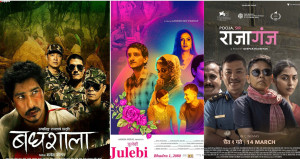Movies
Great acting and stunning visuals can’t always make up for a mediocre script
‘Gangubai Kathiawadi’ could have been a classic had Sanjay Leela Bhansali given ample attention to writing a solid script instead of focusing all of his energy only on the film’s grandeur.
Ankit Khadgi
Bollywood has been churning out a staggering number of biopic movies and popularising the genre in recent years. Every month, at least one movie based on the lives of some unknown or known figures who lived a heroic life, gets screened at the nearest movie theatre or on the OTT platforms.
And to be honest, there’s nothing wrong with this trend. Some larger than life stories deserve to be told through celluloid. But what should worry all of us (especially the filmmakers and cinephiles) is how the emerging genre sets the monotony in filmmaking’s grammar.
In these biopics, the treatment of the protagonists is almost identical. The protagonists are always good people and are treated like demigods. They do nothing wrong. They fight for themselves or others. And in the end, they always manage to triumph over their opponents. Because of this repetitive and predictable narrative arch, the whole movie viewing experience becomes unappealing and lethargic.
Perhaps this is the primary reason why Sanjay Leela Bhansali’s ‘Gangubai Kathiawadi’ fails to live up to its hype. Even if the first half of the film tries to experiment with storytelling, the second half still falls into the trap of the formulaic Hindi biopic.
Based on the chapter ‘The Matriarch of Kamathipura’ of S Hussain Zaidi and Jane Borges’ crime anthology, ‘Mafia Queens of Mumbai’, the film chronicles the real-life journey of Gangubai (played by Alia Bhatt), a sex worker and madam who once ruled Mumbai.
Gangubai becomes a sex worker after the man pretending to be her lover sells her to a trafficker. But what makes her different from other sex workers is that even when she suffers from hardships and traumas, she never stops dreaming. When she lands in Mumbai with her trafficker, she hopes to become a proper Hindi film heroine and rule the hearts of millions of fans.
While her dream of becoming an actor gets shattered when she’s compelled to become a sex worker, she goes on to become the matriarch of Kamathipura and change the lives of her fellow sex workers and rule the hearts of people.
Through cinematographer Sudeep Chhaterjee’s breathtaking camerawork, Bhansali, who has co-written the film, edited, and composed the music, captures the gritty yet inspiring tale of Gangubai. In the first half, we see how a naive and young Ganga becomes Gangu, a high-in-demand sex worker of Kamathipura. Then as the narrative proceeds, we witness the transition of Gangu to Gangubai, a mafia-queen, who runs multiple businesses, and an activist fighting for the rights of sex workers.
Bhansali shows Gangubai and her friends as dignified people who deserve equal rights and respect in the film. The film also explores their dreams, aspirations, interests, camaraderie, sisterhood, and love, which feels like a breath of fresh air, as Hindi movies rarely portray sex workers in such a way.
A large chunk of the film deals with Gangubai’s political journey. After becoming the madam of the brothel she was once sold to, Gangubai looks after all her friends, sex workers in her locality, and makes sure that all of them are paid for their labour. To make a more meaningful impact on the lives of her locality’s people, Gangubai announces her candidacy for the post of the President of Kamathipura and defeats her opponent, Raziabai, a trans madam (played by cisgender actor Vijay Raaz). Similarly, Gangubai is often shown meeting people in power to help sex workers get their rights.
“Sex work is probably human civilisation’s oldest profession. If you want to stop us from working, then destroy the civilisation first,” says Gangubai at a public event in the film.
As Hindi cinema has always limited the depiction of sex workers within the boundaries of their work or shown them as dancers trying to lure men, for a mainstream Hindi film like ‘Gangubai Kathiawadi’ to focus on the subject of sex workers and their fight for dignity and equal rights is a big step forward. But sadly, the film’s weak and mediocre writing makes it less impactful than it would have otherwise been.
Because of its weak narrative building, the film eventually loses momentum. The movie, especially during the second half, places a lot of emphasis on showing Gangubai’s journey, rather than making Bhatt’s character relive the journey. Unlike in the first half, the second half is devoid of emotions. In every scene we see after the interval, Gangubai is always shown fighting the system, police, and society.
However, the many conflicts she faces aren’t the issue because conflicts are the backbones of storytelling. In every film, protagonists are bound to face obstacles in their life and it is their journey of overcoming those obstacles which makes the film what it is.
But the main problem in the film is how easily the conflicts get resolved without Gangubai having to make any efforts. For instance, within one scene, Rahim Lala (played by Ajay Devgan) transforms from being vehemently against working with Gangubai to making her a business partner in his liquor business.
Similarly, in another prominent scene, when Gangubai visits a local school to admit the children of sex workers, the school principal, who had earlier refused to let the children get admission, readily agrees to admit the students. Although such scenes help us realise how Gangubai has become this powerful woman who can make people do what she wants, the ease with which conflicts in the film get resolved is a bit unrealistic.
Thus, the sudden change in the narrative style from a realist drama in the first half to a full-fledged Hindi biopic (with whistle-worthy melodramatic dialogues, repetitive slow pace walks of Gangubai, and the filmmaker’s obsession with making Gangubai a hero in every scene) in the second half diminishes the film’s overall impact.
Yet, regardless of the convoluted script, there are two major reasons why the movie manages to keep the audience glued to the screen.
Firstly, it’s because of the brilliant acting performance by the cast.
Bhatt, who carries the film on her shoulders, shines like a bright moon, radiating both the grace and strength her character requires.
Apart from Bhatt, Indira Tiwari as Kamli, Gangubai’s best friend; Seema Pahwa as Sheela Masi, the madam before Gangubai took over the brothel; and Shantanu Maheswori as Afsaan, Gangubai’s lover; also manage to impress with their performance. While the film has done a good job in ensembling an enviable cast, it also fails in this very department by casting a cisgender male actor (Vijay Raaz) to play the character of Razia bai, a trans woman. The failure from the makers’ side to understand why it was essential to cast a trans actor for trans roles requires more critical introspection.
Another thing going for the film is its visuals. Chatterjee, who often collaborates with Bhansali, creates an entirely immersive world of Gangubai through his camera works. From the single-one take shots to the camera movements and blocking, Chatterjee meticulously designs every shot in the film.
Had Bhansali spent ample time developing a solid script, this film would have been a classic. Perhaps, ‘Gangubai Kathiawadi’ will make him realise that great acting and stunning visuals– which we can find plenty of in his creations–can’t always make up for a mediocre script.




 13.12°C Kathmandu
13.12°C Kathmandu











%20(1).jpg&w=300&height=200)

